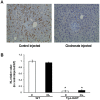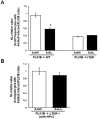LIGHT/TNFSR14 can regulate hepatic lipase expression by hepatocytes independent of T cells and Kupffer cells
- PMID: 23355893
- PMCID: PMC3552851
- DOI: 10.1371/journal.pone.0054719
LIGHT/TNFSR14 can regulate hepatic lipase expression by hepatocytes independent of T cells and Kupffer cells
Abstract
LIGHT/TNFSF14 is a costimulatory molecule expressed on activated T cells for activation and maintenance of T cell homeostasis. LIGHT over expressed in T cells also down regulates hepatic lipase levels in mice through lymphotoxin beta receptor (LTβR) signaling. It is unclear whether LIGHT regulates hepatic lipase directly by interacting with LTβR expressing cells in the liver or indirectly by activation of T cells, and whether Kupffer cells, a major cell populations in the liver that expresses the LTβR, are required. Here we report that LIGHT expression via an adenoviral vector (Ad-LIGHT) is sufficient to down regulate hepatic lipase expression in mice. Depletion of Kupffer cells using clodronate liposomes had no effect on LIGHT-mediated down regulation of hepatic lipase. LIGHT-mediated regulation of hepatic lipase is also independent of LIGHT expression by T cells or activation of T cells. This is demonstrated by the decreased hepatic lipase expression in the liver of Ad-LIGHT infected recombination activating gene deficient mice that lack mature T cells and by the Ad-LIGHT infection of primary hepatocytes. Hepatic lipase expression was not responsive to LIGHT when mice lacking LTβR globally or only on hepatocytes were infected with Ad-LIGHT. Therefore, our data argues that interaction of LIGHT with LTβR on hepatocytes, but not Kupffer cells, is sufficient to down regulate hepatic lipase expression and that this effect can be independent of LIGHT's costimulatory function.
Conflict of interest statement
Figures





Similar articles
-
The Tumor Necrosis Factor Superfamily Members TNFSF14 (LIGHT), Lymphotoxin β and Lymphotoxin β Receptor Interact to Regulate Intestinal Inflammation.Front Immunol. 2018 Nov 22;9:2585. doi: 10.3389/fimmu.2018.02585. eCollection 2018. Front Immunol. 2018. PMID: 30524422 Free PMC article.
-
Lymphotoxin-β receptor activation by lymphotoxin-α(1)β(2) and LIGHT promotes tumor growth in an NFκB-dependent manner.Int J Cancer. 2011 Mar 15;128(6):1363-70. doi: 10.1002/ijc.25456. Int J Cancer. 2011. PMID: 20473944
-
Hepatic lipase inactivation decreases atherosclerosis in insulin resistance by reducing LIGHT/Lymphotoxin β-Receptor pathway.Thromb Haemost. 2016 Aug 1;116(2):379-93. doi: 10.1160/TH15-10-0773. Epub 2016 May 12. Thromb Haemost. 2016. PMID: 27172975
-
LIGHT/HVEM/LTβR interaction as a target for the modulation of the allogeneic immune response in transplantation.Am J Transplant. 2013 Mar;13(3):541-51. doi: 10.1111/ajt.12089. Epub 2013 Jan 28. Am J Transplant. 2013. PMID: 23356438 Review.
-
Cooperation of liver cells in health and disease.Adv Anat Embryol Cell Biol. 2001;161:III-XIII, 1-151. doi: 10.1007/978-3-642-56553-3. Adv Anat Embryol Cell Biol. 2001. PMID: 11729749 Review.
Cited by
-
HVEM structures and mutants reveal distinct functions of binding to LIGHT and BTLA/CD160.J Exp Med. 2021 Dec 6;218(12):e20211112. doi: 10.1084/jem.20211112. Epub 2021 Oct 28. J Exp Med. 2021. PMID: 34709351 Free PMC article.
-
Dendrimer-Based N-Acetyl Cysteine Maternal Therapy Ameliorates Placental Inflammation via Maintenance of M1/M2 Macrophage Recruitment.Front Bioeng Biotechnol. 2022 Jan 28;10:819593. doi: 10.3389/fbioe.2022.819593. eCollection 2022. Front Bioeng Biotechnol. 2022. PMID: 35155393 Free PMC article.
-
Metabolic activation and colitis pathogenesis is prevented by lymphotoxin β receptor expression in neutrophils.Mucosal Immunol. 2021 May;14(3):679-690. doi: 10.1038/s41385-021-00378-7. Epub 2021 Feb 10. Mucosal Immunol. 2021. PMID: 33568785 Free PMC article.
-
T Cells in Atherosclerosis in Ldlr-/- and Apoe-/- Mice.J Immunol Sci. 2018;2(3):69-76. doi: 10.29245/2578-3009/2018/3.1144. Epub 2018 Jun 27. J Immunol Sci. 2018. PMID: 30854522 Free PMC article.
-
LTβR signalling preferentially accelerates oncogenic AKT-initiated liver tumours.Gut. 2016 Oct;65(10):1765-75. doi: 10.1136/gutjnl-2014-308810. Epub 2015 Jul 23. Gut. 2016. PMID: 26206664 Free PMC article.
References
-
- Ware CF (2005) Network communications: lymphotoxins, LIGHT, and TNF. Annu Rev Immunol 23: 787–819. - PubMed
-
- Xu Y, Tamada K, Chen L (2007) LIGHT-related molecular network in the regulation of innate and adoptive immunity. Immunol Res 37: 17–32. - PubMed
-
- Lee WH, Kim SH, Lee Y, Lee BB, Kwon B, et al. (2001) Tumor necrosis factor receptor superfamily 14 is involved in atherogenesis by inducing proinflammatory cytokines and matrix metalloproteinases. Arterioscler Thromb Vasc Biol 21: 2004–2010. - PubMed
-
- Scholz H, Sandberg W, Damås JK, Smith C, Anreassen AK, et al. (2005) Enhanced plasma levels of LIGHT in unstable angina: possible pathogenic role in foam cell formation and thrombosis. Circulation 112: 2121–2129. - PubMed
Publication types
MeSH terms
Substances
Grants and funding
LinkOut - more resources
Full Text Sources
Other Literature Sources
Molecular Biology Databases
Research Materials

